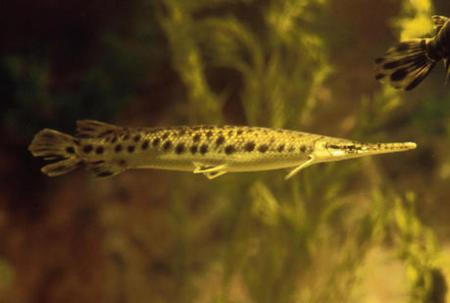Gars
-
Scientific Name
Lepisosteidae family - Visit ITIS for full scientific classification.
-
Description
 Spotted Gar. © US Fish and Wildlife Service.
Spotted Gar. © US Fish and Wildlife Service.- Large, freshwater fish with a slender, cylindrical body.
- Gars have hard, bony, scale-less heads and snouts with elongated jaws lined with long, sharp teeth.
- They have diamond-shaped and non-overlapping scales.
- Patterns and coloration can vary between the 7 different species: Alligator, Shortnose, Longnose, Spotted, Cuban, Florida, Tropical.
- The largest gar reported was about 10 feet and 350 pounds.
-
Habitat
- Gars are adapted to live in harsh environments as their swim bladders are connected to their throats.
- They can use this swim bladder as a lung to breath air, surviving waters with low oxygen levels.
- Gars are usually found in low flow areas with a lot of vegetation, and they prefer warm, shallow pools in rivers and lakes.
-
Invasion Pathways and Distribution
- Gars are popular aquarium and game fish.
- They can spread when pet owners release them into the wild.
- They can also spread when they're introduced for sport fishing, and when they escape from fish farms.
- Native ranges differ between species.
- The Alligator, Shortnose, Longnose, Spotted, and Florida Gars are all native to the U.S. None of the species are currently found in California.
- See USGS for current U.S. distributions.
-
Life History
- Mating can occur when the water temperature is warmer than 68 degrees F.
- Depending on the species, spawning will occur over a bed of vegetation or gravel, and the young fish will then attach to an object to begin development.
-
Impacts
- Aggressive top predators that feed on a wide variety of animals including: fish, crabs, birds, small mammals, turtles, etc.
- Gars themselves have few natural predators, giving them great potential to prey upon, and outcompete native species.
-
References and Useful Links
For references by category and links to other useful AIS sites see our LEARN MORE page.

